Exhibitions 2011
Quiet Resistance. Russian pictorial photography 1900–1930
16 November to 18 December 2011
This text is only available in German

Poster of the exhibition “Quiet Resistance. Russian pictorial photography 1900–1930”. Image: Leonid Schokin. An der Wolga. Kimry (1930)
© Moskauer Haus der Fotografie
Ai Weiwei in New York. Photographs 1983-1993
15 October 2011 to 18 March 2012
For the first time in Germany, the Martin-Gropius-Bau is showing more than 220 photographs from the period 1983 to 1993 spent by Chinese artist Ai Weiwei in New York. More than 10,000 photos emerged during this time. Ai acted as curator selecting what will be exhibited. For the young Ai, born in 1957, this extended period of stay in the USA was very influential on the style of his future artistic works. After being in New York, Ai first of all returned to China as his father, the very famous author Ai Qing whose poems every Chinese schoolchild learns by heart, was on his deathbed.
Today, Ai Weiwei is one of the most famous Chinese artists of contemporary times. While living in New York, he became friends with Allen Ginsberg. Many artists who are now famous in China visited him there and Ai photographed them. He became familiar with the works of Joseph Beuys, whose ideas on Social Plastic are recognisable in Ai's work today. Andy Warhol was also an influence.
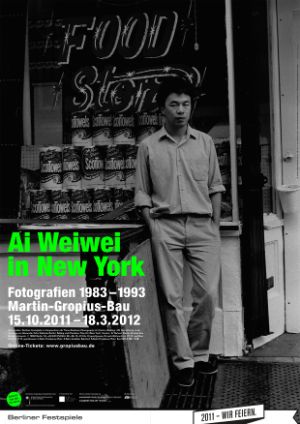
Poster of the exhibition “Ai Weiwei in New York – Photographs 1983-1993”
Design: Steenbrink Vormgeving, Berlin
W. Eugene Smith. Photographs. A retrospective
25 September to 27 November 2011
W. Eugene Smith, who was born in 1918 in Wichita, Kansas, and died in 1978 in Tucson, Arizona, first made a name for himself as a politically and socially committed photojournalist in the USA in the 1940s. Many of his photographic reports appeared in Life, the leading picture magazine that had been launched in New York in 1936. Smith saw in photography more than just an illustration to a text and had often asked editors for a greater say in the composition of a photo-essay. His painstakingly researched and emotionally moving features set new standards of photojournalism in the 1940s and 1950s.
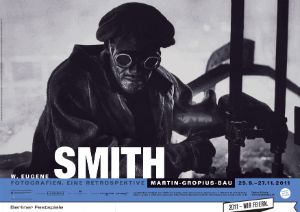
Poster of the exhibition “W. Eugene Smith – Photographs. A retrospective”. Photo: W. Eugene Smith: Steelworker, Pittsburgh, 1955, Center for Creative Photography, University of Arizona: W. Eugene Smith Archive / Gift of the artist
© The Heirs of W. Eugene Smith, courtesy Black Star, Inc., New York
Side by Side. Poland – Germany. A 1000 Years of Art and History
23 September 2011 to 9 January 2012
The Royal Castle in Warsaw and Martin-Gropius-Bau, Berlin are jointly developing the exhibition entitled “Side by Side. Poland – Germany. A 1000 Years of Art and History” which will be on view in Berlin from September 23, 2011 to January 9, 2012.
The exhibition is being shown as part of the International Cultural Programme of the Polish EU Presidency 2011.
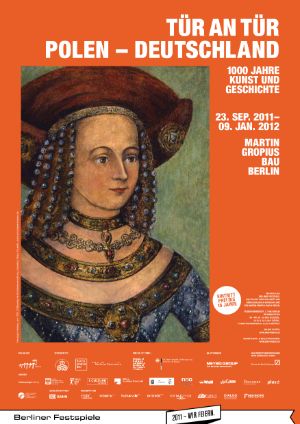
Poster of the exhibition “Side by Side. Poland – Germany. A 1000 Years of Art and History”
Hokusai. Retrospective
26 August to 31 October 2011
For the first time in Germany a major retrospective is to be devoted to the world-famous Japanese artist Hokusai (1760–1849). Perhaps his best-known picture is the woodcut: “The Great Wave off Kanagawa” from the series: “Thirty-six Views of Mount Fuji” (1823–29). Over 350 loans, which with few exceptions come from Japan, will be on display in the exhibition in Berlin’s Martin-Gropius-Bau. NAGATA Seiji, the leading Japanese authority on Hokusai and his work, will be curating the exhibition, which is to be seen exclusively in Berlin. Works from all periods of the artist’s career – woodcuts and drawings, illustrated books, and paintings – will be shown.
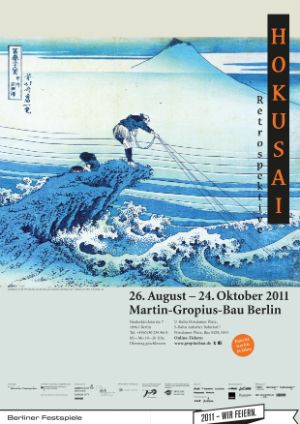
Poster of the exhibition “Hokusai – Retrospective”. Image: Kajikazawa in Kai province. From the series Thirty-six Views of Mount Fuji (detail). Date of origin: c. 1831 | Period: Iitsu
© Sumida City
Competition Kunst-am-Bau Martin-Gropius-Bau
29 June to 17 July 2011
This text is only available in German
Snow in Samarkand. Views from the Hinterland of War. Photographs by Daniel Schwartz
23 June to 12 September 2011
The exhibition confronts burning issues of the day. It takes us to Afghanistan and Central Asia and shows the history, geography and current state of a region that stretches from the Caspian Sea to the deserts of western china and from Kazakhstan in the north to Pakistan and Iran in the south. This region is constantly in the news as the scene of constant wars and latent conflicts.
In his work the internationally renowned Swiss photographer and author Daniel Schwartz examines the geographically heterogeneous and politically complex area of Central Asia both from the inside and from European, Chinese and Persian/Arab perspectives.
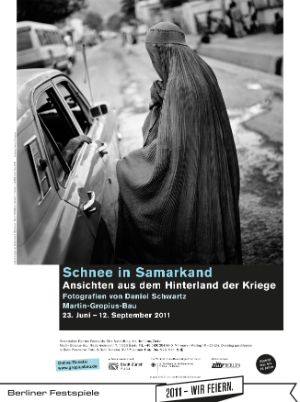
Poster of the exhibition “Snow in Samarkand – Views from the Hinterland of War. Photographs by Daniel Schwartz”
Design: Steenbrink Vormgeving, Berlin
André Kertész. Photographs
11 June to 11 September 2011
As the creator of images like “Underwater Swimmer” (1917), “Chez Mondrian” (1926) or “Gabel” (1929) André Kertész has a firm place in 20th century photographic history. It is not only his formally outstanding compositions which won him great esteem, but the surreally inspired poetry with which he captures such apparently simple things and situations. His innovative photographic instinct inspired many of his colleagues: Brassaï learned from him and Henri Cartier-Bresson betrays his influence.
Berlin’s Martin-Gropius-Bau is showing a grand retrospective of over 300 photographs by André Kertész, who was born in Hungary and lived in Budapest, Paris and New York.
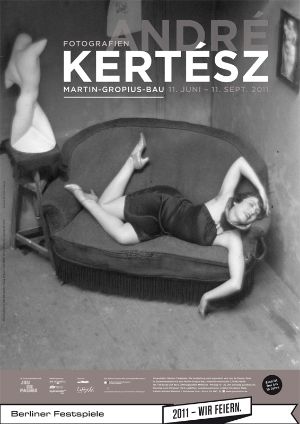
Poster of the exhibition “André Kertész – Photographs”
Design: Steenbrink Vormgeving, Berlin
When the Curtain Falls. Margarita Broich – Photographs
18 March to 30 May 2011
As an actress Margarita Broich is one of the big names, but it may come as a surprise to many that she is also a photographer. For the first time the Martin-Gropius-Bau is showing an exhibition of her work consisting of over 60 portraits of her fellow artists, including Ben Becker, Kate Winslet, Veronika Ferres, Klaus Maria Brandauer, Christoph Schlingensief, Thomas Quasthoff and many more. Margarita Broich has captured those fleeting moments when the actor sheds the role in the intervals or a few minutes after the end of a performance. The role can still be discerned on the features of the players when they are still surrounded by the world of scenery and mirrors but not acting any more. They have been sought out in changing rooms, theatre foyers, or with the make-up artist, taking off their make-up while still surrounded by the tools of their transformation.
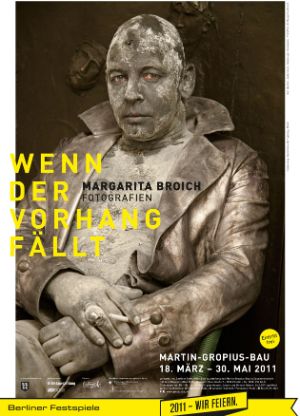
Poster of the exhibition “When the Curtain Falls. Margarita Broich – Photographs”
Design: Steenbrink Vormgeving, Berlin
Compass. Drawings from the Museum of Modern Art New York. The Judith Rothschild Foundation Contemporary Drawings Collection
11 March to 29 May 2011
Compass present an extensive selection from The Judith Rothschild Foundation Contemporary Drawings Collection, an extraordinary treasure trove of nearly 2.600 works on paper by over 600 artists, acquired by The Museum of Modern Art (MoMA) in may 2005.
The collection was amassed between 1003 and 2005 with the intention to give a broad overview over the medium of drawing in all its material manifestations at that time. It includes studies and sketches as well as monumental finished works; works painstakingly produced with the help of technical tools such as rulers and spontaneous scribbles with no special regard for finish; narrative and figurative works and a broad range of abstractions; works in traditional media such as pencil, watercolours and gouache, and various print techniques, as well as rubbings and transfers of soil, pigments, plant extracts, soot, foodstuffs, and body fluids; it incorporates assemblage, collage, and found objects.
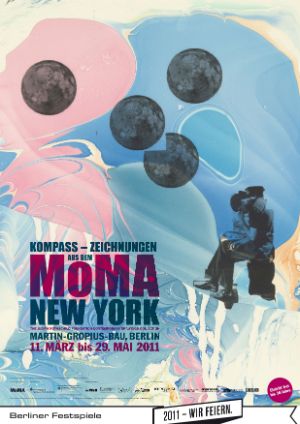
Poster of the exhibition “Compass – Drawings of the Museum of Modern Art New York”